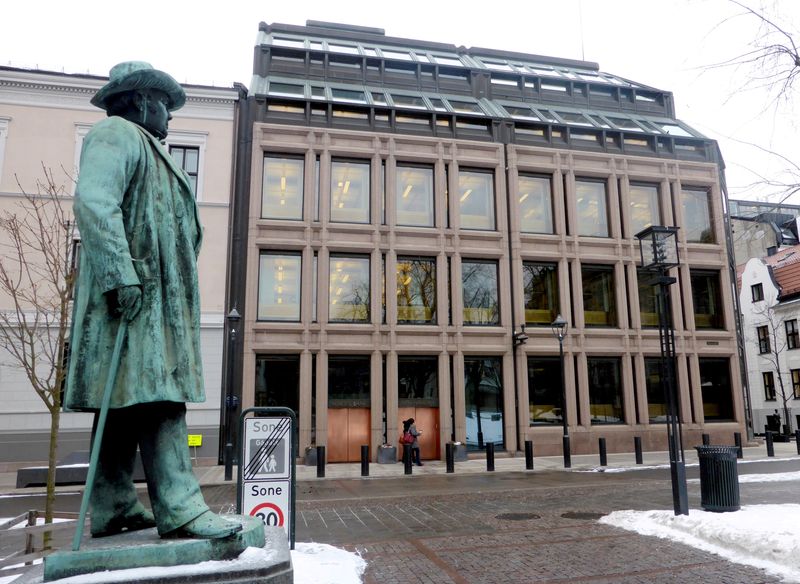LONDON (Reuters) - The Norwegian and New Zealand central banks this week both delivered yet more interest rate hikes and signalled further tightening is round the corner as policymakers globally race to get on top of runaway inflation.
Central banks from the United States to Canada, Australia and Switzerland have lined up with aggressive rate rises recently. The European Central Bank last month delivered its first rate hike since 2011.
Japan, which is yet to lift rates in this cycle, is the holdout dove among the 10 big developed economies.
In total, those central banks have so far raised rates in this cycle by a combined 1,415 basis points.
Here's a look at where policymakers stand in the race to contain inflation.
Graphic: G10 interest rates https://graphics.reuters.com/BRITAIN-BOE/klvykwlngvg/chart.png
1) UNITED STATES
The Federal Reserve last month delivered its second straight 75 basis-point (bps) rate rise. Though inflation surprised by not rising in July, Fed officials have reiterated their determination to get on top of red-hot price pressures with tighter monetary policy.
Following the inflation print markets reduced their bets on a third 75 bps move in September, now seeing a 40% chance. Even as growth worries mount, analysts say containing inflation will remain the Fed's priority.
Graphic: U.S. CPI vs 10-year Treasury yield https://fingfx.thomsonreuters.com/gfx/mkt/dwpkrwyaavm/us%20cpi%20chart.PNG
2) CANADA
The Bank of Canada last month delivered the first 100-bps rate increase among the world's advanced economies in the current policy-tightening cycle. It lifted its key policy rate to 2.5%.
With annual inflation running way above target and the highest in nearly four decades, analysts reckon another rate hike in September is highly likely.
Graphic: Canada in the hawkish camp https://fingfx.thomsonreuters.com/gfx/mkt/zdpxobjywvx/CA2107.PNG
3) NEW ZEALAND
The Reserve Bank of New Zealand on Wednesday delivered its seventh straight hike -- and fourth consecutive rise of 50 bps -- to lift rates to 3%, the highest since September 2015.
The RBNZ also struck a more hawkish than expected tone as it battles soaring inflation. It now sees rates at 4% by early next year, compared to its previous projection of 3.7%, implying at least one more 50 bps rate hike at upcoming meetings.
Graphic: RBNZ https://fingfx.thomsonreuters.com/gfx/mkt/movangbwrpa/Pasted%20image%201660737709275.png
4) BRITAIN
The Bank of England this month lifted its key rate by half a percentage point to 1.75% - its highest level since late 2008.
The BoE also warned that Britain was facing a recession with a peak-to-trough fall in output of 2.1%, similar to a slump in the 1990s. Despite those recession risks, double-digit inflation now has investors betting rates won't peak until another 200 bps of hikes by May 2023.
Graphic: BoE rate moves https://graphics.reuters.com/BRITAIN-BOE/myvmnenzgpr/chart.png
5) NORWAY
Norway, the first big developed economy to kick off a rate-hiking cycle last year, on Thursday jacked up rates another 0.5% to 1.75% and said more hikes were in the pipeline, probably including one in September.
6) AUSTRALIA
The Reserve Bank of Australia this month raised rates by 50 bps, tightening policy for a fourth month running. But it tempered guidance on further hikes as it forecast faster inflation but also a slowdown in the economy.
The RBA has now delivered 175 bps of hikes since May, taking its key rate to 1.85%, in the most drastic tightening since the early 1990s.
Graphic: G10 policy rates https://fingfx.thomsonreuters.com/gfx/mkt/gdpzyoaqevw/g10%20policy%20rates.PNG
7) SWEDEN
Another late-comer to the inflation battle, Sweden's Riksbank delivered a half percentage-point interest rate hike on June 30 to 0.75%, its biggest hike in more than 20 years.
As recently as February, the Riksbank had forecast unchanged policy until 2024, but governor Stefan Ingves now expects rates to hit 2% in early 2023 and said 75 bps moves are possible.
8) EURO ZONE
The ECB last month hiked its deposit rate by 50 bps -- more than it initially guided -- in its first rate rise since 2011 to fight soaring inflation. The move to 0% ended an eight year experiment with negative rates.
The bank is expected to hike rates again at its next meeting on Sept. 8, with money markets pricing a full probability they will be jacked up to 0.5%.
Graphic: ECB monetary policy https://fingfx.thomsonreuters.com/gfx/mkt/akpezkyqkvr/ecb%20monetary%20policy.PNG
9) SWITZERLAND
On June 16, the Swiss National Bank (SNB) unexpectedly raised its -0.75% interest rate, the world's lowest, by 50 bps, sending the franc soaring.
Recent franc weakness has contributed to driving Swiss inflation towards 14-year highs and SNB governor Thomas Jordan said he no longer saw the franc as highly valued. That has opened the door to more rate hikes including at its next meeting on Sept. 22.
10) JAPAN
Japan is the holdout dove. The Bank of Japan in July maintained ultra-low interest rates of -0.1% and signalled its resolve to keep them that way even as it projected inflation would exceed its target this year.

BOJ Governor Haruhiko Kuroda said he had no plan to raise rates or hike an implicit 0.25% cap set for the bank's 10-year bond yield target, because Japan was still recovering from the pandemic and its terms of trade had worsened.
Graphic: BOJ is the last dove standing https://fingfx.thomsonreuters.com/gfx/mkt/klvykrzggvg/Pasted%20image%201655441669556.png